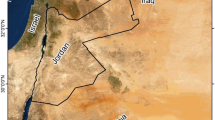Abstract
The study of urban outdoor thermal environment was carried out in one of the mountainous cities by using geography information system(GIS) technique which is connected with predicting and evaluating models for the outdoor thermal environment, monitoring data and simulating data. A prediction and evaluation system were set up. A typical mountainous city, i.e., Yunyang city in Chongqing in China, was taken as an example, its urbanization trend and population growth was predicted and evaluated. The heat island intensity and its trend were simulated, the temperature field, velocity field and the humidity field were analyzed. The results show that GIS is an effective tool to deal with the outdoor thermal environment, especially for the mountainous cities with special geographical particularities. GIS can be used in the environmental management and the city planning especially for the mountainous cities.
Similar content being viewed by others
References
LU Jun, FENG Yuan. High-rise influences on campus’ thermal environment[J]. Refrigeration and Air Condition, 2005(Suppl): 251–254. (in Chinese)
LIU Shu-li, LU Jun, CHEN Jing. Embody the GIS analysis of urban heat island in city planning[J]. Mapping Information Engineering, 2003, 8(6): 48–50. (in Chinese)
HE Ping, LI Hong-bo. Heat island effect analysis at Altiplano of Yunnan[J]. Weather Science and Technology, 2002, 5(10):288–291. (in Chinese)
HU Yuan-man, XU Chong-gang. The application of GIS in the research of urban heat island[J]. Environmental Protection Science, 2002, 28: 1–3. (in Chinese)
Dhakal S H, Hanaki K S. Improvement of urban thermal environment by managing heat discharge sources and surface modification in Tokyo [J]. Energy and Building, 2002, 34(12): 13–23.
CHEN En-shui. The thermal environmental analysis in the south of Suzhou in summer[J]. Journal of Southeast University, 2004, 27(6):123–127. (in Chinese)
GUO Gui-xiang, CHEN Dong-wei. On thermal pollution[J]. Environmental Production, 1994 (4): 33–37. (in Chinese)
Haklay M, Feitelson E, Doytsher Y. The Potential of a GIS-Based scoping system: an Israeli proposal and case study[J]. Environmental Impact Assessment Review, 2000, 18(5): 439–459.
Basnet B B, Apan A A, Raine S R. Selecting suitable sites for animal waste application using a raster GIS[J]. Environmental Management, 2001, 28(4): 519–531.
LI Yin-zhi, QIN Da-guo. The key problems in the development of GIS[J]. Systems Engineering and Electronics, 1999, 21(12): 95–97. (in Chinese)
WU Lun, LIU Yu, ZHANG Jing. The principle, method and application of GIS[M]. Beijing: Science Press, 2002: 28–31. (in Chinese)
Author information
Authors and Affiliations
Corresponding author
Additional information
Foundation item: Project (50278099) supported by the National Natural Science Foundation of China
Rights and permissions
About this article
Cite this article
Lu, J., Chen, Jh., Gao, Yf. et al. Outdoor thermal environmental research of the mountainous city by GIS. J Cent. South Univ. Technol. 13, 225–228 (2006). https://doi.org/10.1007/s11771-006-0135-0
Received:
Accepted:
Issue Date:
DOI: https://doi.org/10.1007/s11771-006-0135-0




